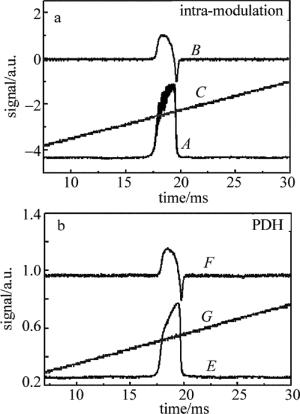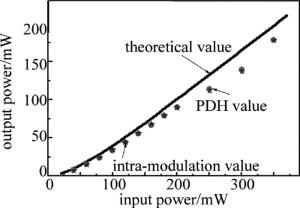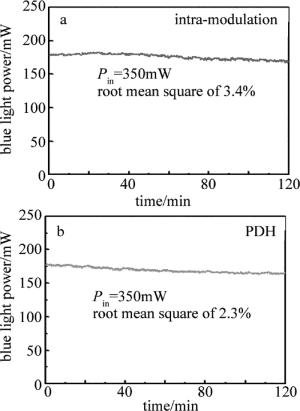-
具有窄线宽及高稳定性输出的激光器在新型量子频标、量子计量及原子物理等众多实验研究中有着重要的应用[1]。特别是近年来发展迅猛, 将对应于原子吸收线的非经典光,应用在原子领域,如原子系综之间的纠缠[2]、量子存储[3]、光与原子相互作用[4]和光谱测量[5]等。为了制备对应于原子吸收线的非经典光,首先需要利用外腔倍频产生高质量的抽运源[6-10]。但是由于外界存在的温度起伏、机械振动及其它干扰,使得抽运源在自由运转时起伏较大,因此需要对倍频腔进行锁定[11-12]。2013年,日本电气通信大学的ZHANG等人[13]利用Hansch-Couillaud技术实现对798nm光外腔倍频产生1.1W的399nm激光,转换效率为70%,2.5h内功率起伏为3%。2008年,山西大学FENG等人[14]利用内调制技术实现对1560nm光外腔倍频产生718mW的780nm红外光,转换效率为65%,1h内功率起伏小于2%。2009年,山西大学的GE等人[15]利用相位调制光外差(Pound-Drever-Hall, PDH)稳频技术实现了对1342nm红外光进行外腔倍频产生580mW的671nm红光,对应的倍频效率为50.9%,1h内功率起伏小于0.5%。主动稳频的主要原理是当外界扰动使得倍频腔的共振频率偏离基频光的频率时,自动伺服系统会通过压电陶瓷调节腔长使得基频光在腔内共振,实现倍频光稳定输出。
作者利用以周期性极化KTP晶体作为非线性晶体构建的两镜驻波倍频腔对894.6nm连续光进行外腔倍频产生稳定输出的447.3nm蓝光,分别采用内调制技术和PDH稳频技术对倍频腔进行锁定,在多个注入光功率下测量了两种方法的倍频效率;在最大注入光功率为350mW时,获得蓝光功率都为178mW,对应的倍频效率为50.8%。比较了两种方法锁定后蓝光的功率起伏,由于内调制稳频始终在压电陶瓷上加有一个低频调制使得倍频腔有微小扰动,因此其输出稳定性低于PDH稳频,二者2h内功率起伏分别为3.4%(内调制)和2.3%(PDH)。产生的蓝光将应用于下一步制备铯原子D1线非经典光的实验研究中。
-
实验装置如图 1所示,光源由激光器和半导体锥形放大器(tape photo amplifier, TPA)组成。激光器为Toptica公司生产的光栅外腔半导体激光器(DL100),在894.6nm处最大输出功率为28mW,线宽为1MHz。进行实验时,为防止激光器跳模和功率漂移,利用偏振光谱技术将其精确的锁定在铯原子吸收线上。它输出的红外光经光纤整形后注入自制TPA进行功率放大,TPA的激光二极管由EAGLEYARD公司生产(EYP-TPA-0915-01500-3006-CMT03-0000)。放大后的红外光输出功率达800mW。放大光经过光学隔离器用以防止光反馈进入TPA,通过相位调制器(phase modulator, PM)(New Focus, 4002)对红外光进行相位调制后最终注入倍频腔。倍频腔采用两镜驻波腔结构,前腔镜曲率半径为30mm,凹面对蓝光反射率大于99.5%,对红外光的透射率为5%,平面对红外光反射率小于0.25%。后腔镜曲率半径为50mm,凹面对红外光反射率大于99.5%,对蓝光透射率大于95%,平面对蓝光反射率小于0.25%。倍频腔使用的非线性晶体为周期性极化KTP(periodically poled KTP, PPKTP),尺寸为1mm×2mm×10mm,在透光方向的两个平面镀有双色减反膜,它被放置在紫铜制的晶体炉内用以控制晶体的温度,控温精度为0.1℃。晶体的中心位于倍频腔的腰斑处,腰斑尺寸为39μm。倍频腔以及匹配透镜置于长度可调节的导轨上,可以精确调节腔镜、晶体及匹配透镜的位置,而且整体结构紧凑,为蓝光的稳定输出提供了保障。分别用两种方法进行倍频腔的锁定:(1)内调制稳频(如图 1中虚线框1所示)。锁相放大器(Stanford Research System, SR830)输出频率为74.6kHz的正弦信号对倍频腔的压电陶瓷进行低频调制,同时扫描腔长,将倍频腔透射信号输入锁相放大器并调节锁相放大器参量获得最佳鉴频信号输出,将鉴频信号输入比例-积分-微分(proportion-integral-differentiation, PID)进行积分后经过高压放大器驱动压电陶瓷,此时在不扫描腔长的情况下通过鉴频信号对频率抖动的纠偏特性来控制腔长实现腔长锁定;(2)PDH稳频技术(如图 1中虚线框2所示)。射频(radio frequency, RF)信号源(Stanford Research System, DS345)输出频率为26.4MHz、振幅为7V的正弦信号,经过功率分束器(power beam splitter, PBS)后分为两路,一路加载到相位调制器上对红外光进行相位调制,另一路经过位相延迟盒(Φ)后输入乘法器(Mini-Circuits, ZAD-1+)与腔的透射信号相乘产生误差信号,误差信号经过低通滤波器(low pass filter, LPF)(Mini-Circuits, BLP-1.9+)将高频信号过滤后输入PID进行积分,通过高压放大器驱动压电陶瓷实现腔长的锁定。腔的输出光包含少量透射的红外光及倍频产生的蓝光,经过分色镜后将两束光分离-透射的红外光用来锁腔,蓝光被反射后测量功率。
-
图 2为扫腔时两种情况下的透射峰(曲线A, E)、鉴频信号(曲线B, F)及扫描信号(曲线C, G),透射峰的不对称是由于倍频晶体的热效应造成[16]。可以看出,由于内调制稳频在压电陶瓷上加有一个低频调制信号(74.6kHz),导致了腔透射峰的微小抖动,即使在腔锁定后低频信号依然存在,在一定程度上影响了输出蓝光的稳定性。
内调制稳频操作比较简单,由于调制信号直接加在腔上,因此产生的鉴频信号信噪比较高。PDH稳频则是在基频光上调制的高频信号(26.4MHz),不会对腔的锁定造成干扰,能够很好地消除低频噪声,因此输锁定倍频腔后输出的447.3nm蓝光具有较好的高斯横模特性,如图 3所示。
实验中测量了用两种方法锁腔后蓝光功率随着注入光功率变化而改变的情况,结果如图 4所示。其中黑色线是理论值,星和圈分别为内调制和PDH锁腔后的蓝光功率。可以看出,在不同入射光功率下,用两种方法锁腔后输出的蓝光功率基本相等。
理论上,倍频光与基频光功率的关系可以表示为[6]:
$\sqrt {{P_2}/{P_1}} {\left[ {2 - \sqrt {1 - {T_1}} \left( {2 - L - \mathit{\Gamma }\sqrt {{P_2}/{E_{{\rm{NL}}}}} } \right)} \right]^2} - 4{T_1}\sqrt {{E_{{\rm{NL}}}}{P_1}} = 0 $
(1) 式中,P2为输出蓝光功率,P1为红外光功率,T1为倍频腔前腔镜对红外光的透射率(5%),L为除了T1以外的内腔损耗(实验中测量值为2.7%),非线性损耗Γ=ENL+Γabs,ENL为晶体的单次穿过效率(实验中测量值为0.89%/W),Γabs为晶体对蓝光的吸收,根据参考文献[16]和参考文献[17],晶体对蓝光的吸收系数为10%/cm~20%/cm,这里取Γabs=0.1ENL。从图 4中可以看出,在不同注入光功率时用两种方法得到的蓝光功率基本相等。在注入光功率较低时,实验值与理论值符合较好,而随着红外光功率的增加,实验值略小于理论值,这是由于在较高功率下,晶体对蓝光及红外光吸收增大造成的。在注入光功率为350mW时,输出蓝光功率约为178mW,相应的倍频效率为50.8%。
利用参量下转换产生894.6nm非经典光的实验对抽运光的稳定性要求较高,因此作者还测量了两种方法锁定后的蓝光功率起伏,结果如图 5所示。从图中可以看出,利用PDH锁定倍频腔后输出的蓝光稳定性比内调制高,二者2h内功率起伏分别为3.4%(内调制)和2.3%(PDH)。
-
介绍了利用内调制技术和PDH稳频技术两种方法实现两镜驻波倍频腔的锁定,通过对894.6nm连续光外腔倍频, 获得178mW的447.3nm蓝光稳定输出。比较了两种方法的倍频转换效率和功率输出稳定性,所得蓝光为制备对应于铯原子D1线非经典光的实验研究奠定了基础。
内调制技术和Pound-Drever-Hall技术对894.6nm倍频腔的稳频比较
Comparison of frequency locking of 894.6nm frequency doubling cavity using intra-modulation technology and Pound-Drever-Hall technology
-
摘要: 为了对抽运源的稳频技术做出对比和选择,采用内调制技术和相位调制光外差技术,以周期性极化KTP晶体作为非线性晶体,实现了894.6nm连续光两镜驻波倍频腔的稳频运转。结果表明,在不同注入光功率下,用这两种方法锁定倍频腔后获得的蓝光功率基本相同;在最大注入光功率为350mW时,获得178mW的447.3nm蓝光,相应的转化效率为50.8%;在最大注入光功率下,利用内调制技术和相位调制光外差稳频技术获得的蓝光在2h内功率起伏分别为3.4%和2.3%。该研究对获得稳定输出的447.3nm蓝光用来制备铯原子D1线的非经典光的实验是有帮助的。Abstract: In order to compare and select the technology of locking frequency of pump source, by using intra-modulation technology and Pound-Drever-Hall(PDH) technology separately, and choosing periodically poled KTP(PPKTP) crystal as nonlinear crystal, stable frequency operation of 894.6nm continuous light two-mirror standing wave frequency doubling cavity was realized. The results show that frequency doubling cavity has the same blue light power output using two locking technologies and under different input light powers. 447.3nm blue light of 178mW is obtained when the maximum fundamental light power of 350mW and the corresponding conversion efficiency is 50.8%. Under the condition of the maximum fundamental power, the power fluctuation of blue light obtained by intra-modulation technology and PDH technology are 3.4% and 2.3% in 2h respectively. The research is helpful for preparing stable output of 447.3nm blue light to obtain nonclassical light source at D1 line of cesium atom.
-
[1] LANCASTER G P T, CONROY R S, CLIFFORD M A, et al. A polarisation spectrometer locked diode laser for trapping cold atoms[J]. Optics Communications, 1999, 170(1/3):79-84. [2] YUAN Z S, CHEN Y A, ZHAO B, et al. Experimental demonstration of a BDCZ quantum repeater node[J]. Nature, 2008, 454(28):1098-1101. [3] APPEL J, FIGUEROA E, KORYSTOV D, et al. Quantum memory for squeezed light[J]. Physical Review Letters, 2008, 100(9):093602. doi: 10.1103/PhysRevLett.100.093602 [4] HALD J, SØRENSEN J L, SCHORI C, et al. Spin squeezed atoms:A macroscopic entangled ensemble created by light[J]. Physical Review Letters, 1999, 83(7):1319-1322. doi: 10.1103/PhysRevLett.83.1319 [5] POLZIK E S, CARRI J, KIMBLE H J. Spectroscopy with squeezed light[J]. Physical Review Letters, 1992, 68(20):3020-3023. doi: 10.1103/PhysRevLett.68.3020 [6] WEN X, HAN Y S, BAI J D, et al. Cavity-enhanced frequency doubling from 795nm to 397.5nm ultra-violet coherent radiation with PPKTP crystals in the low pump power regime[J]. Optics Express, 2014, 22(26):32293-32300. doi: 10.1364/OE.22.032293 [7] LI J H, ZHENG H Y, ZHANG L, et al. 397.5nm laser produced by resonant frequency doubling with ppktp crystal[J]. Acta Sinica Quantum Optica, 2011, 17(1):30-33(in Chinese). [8] HETET G, GLOCKL O, PILYPAS K A, et al. Squeezed light for bandwidth-limited atom optics experiments at the rubidium D1 line[J]. Journal of Physics, 2007, B40(1):221-226. [9] TANIMURA T, AKAMATSU D, YOKOI Y, et al. Generation of a squeezed vacuum resonant on a rubidium D1 line with periodically poled KTiOPO4[J]. Optics Letters, 31(15):2344-2346. doi: 10.1364/OL.31.002344 [10] WANG F Y, SHI B S, CHEN Q F, et al. Efficient cw violet-light generation in a ring cavity with a periodically poled KTP[J]. Optics Communications, 2008, 281(15/16):4114-4117. [11] CAO Y J, LIU Y, CHEN G L, et al. Study on vibrational stabilization of cylindrical cavities[J]. Laser Technology, 2012, 36(2):265-267(in Chinese). [12] GENG W B, HU Sh L, SHAO H F. Design of laser frequency stabilization systems based on FPGA and Pound-Drever-Hall technique[J]. Laser Technology, 2014, 38(5):665-668(in Chinese). [13] ZHANG Y, HOSHI R, YAMAGUCHI D, et al. Generation of quasi-cw deep ultraviolet light below 200nm by an external cavity with a Brewster-input KBBF prism coupling device[J]. Optics Communications, 2013, 295(10):176-179. [14] FENG J X, LI Y M, TIAN X T, et al. Noise suppression, linewidth narrowing of a master oscillator power amplifier at 1.56μm and the second harmonic generation output at 780nm[J]. Optics Express, 2008, 16(16):11871-11877. doi: 10.1364/OE.16.011871 [15] GE Q, YU L, JIA X J, et al. Extracavity frequency doubled red laser with single frequency[J]. Chinese Journal of Lasers, 2009, 36(7):1744-1748(in Chinese). doi: 10.3788/JCL [16] HAN Y S, WEN X, BAI J D, et al. Generation of 130mW of 397.5nm tunable laser via ring-cavity-enhanced frequency doubling[J].Journal of the Optical Society of America, 2014, B31(8):1942-1947. [17] DENG X, ZHANG J, ZHANG Y C, et al. Generation of blue light at 426nm by frequency doubling with a monolithic periodically poled KTiOPO4[J].Optics Express, 2013, 21(22):25907-25911. doi: 10.1364/OE.21.025907 -


 网站地图
网站地图


 下载:
下载:






